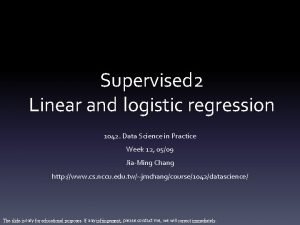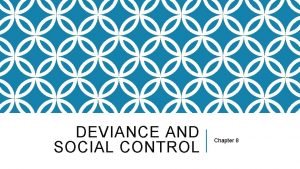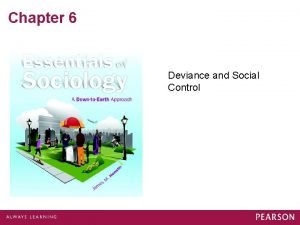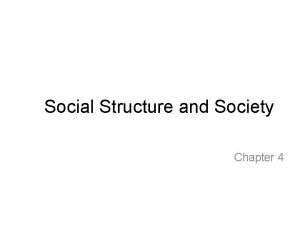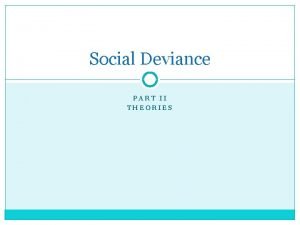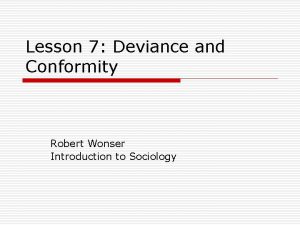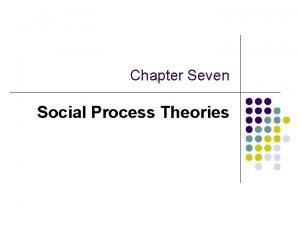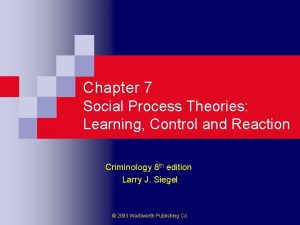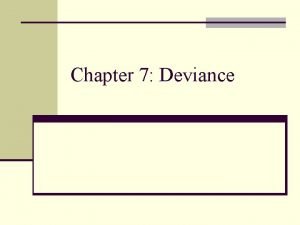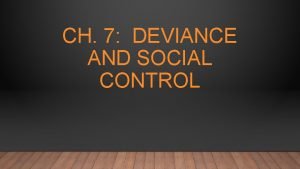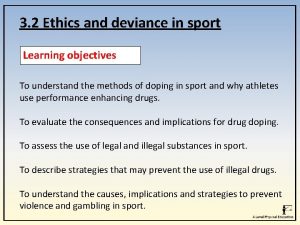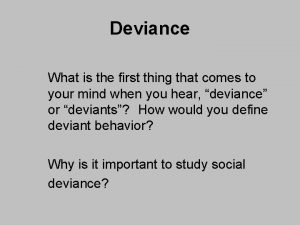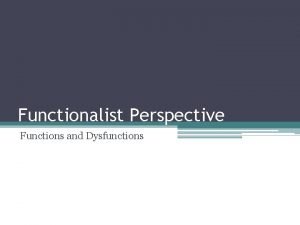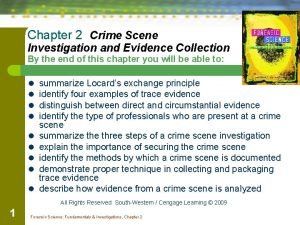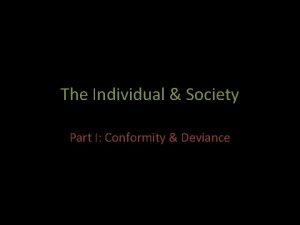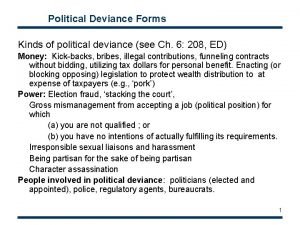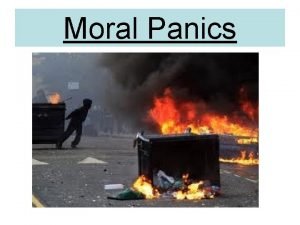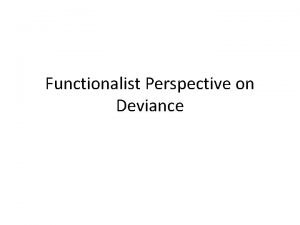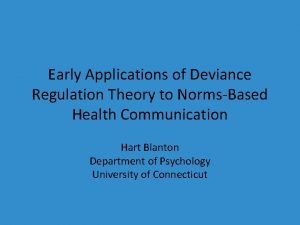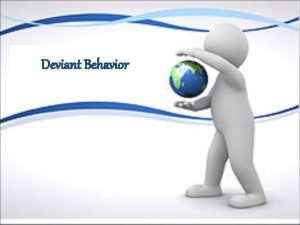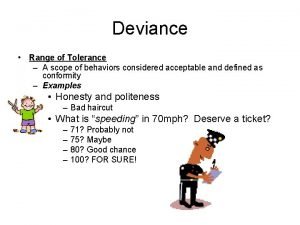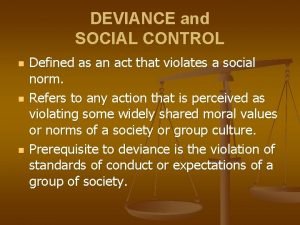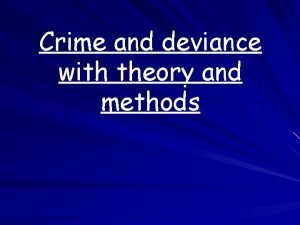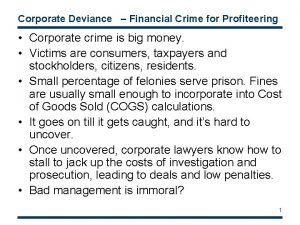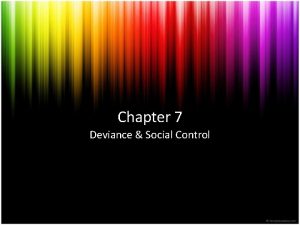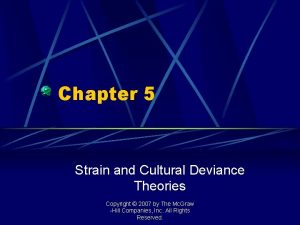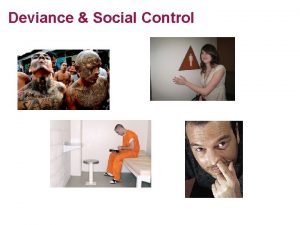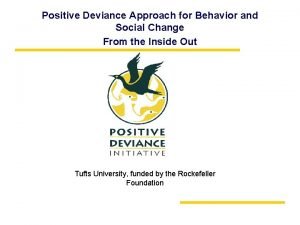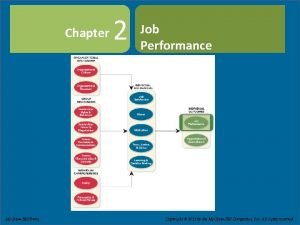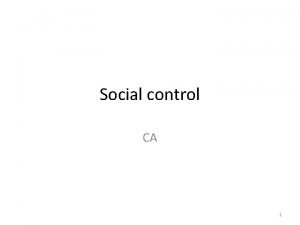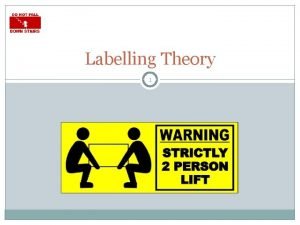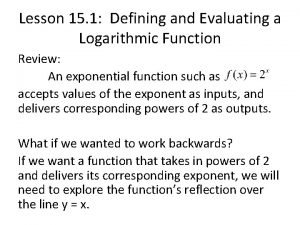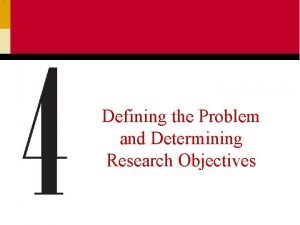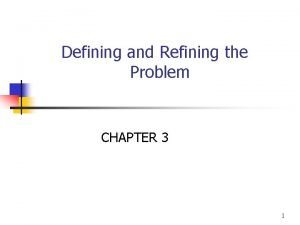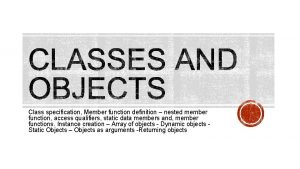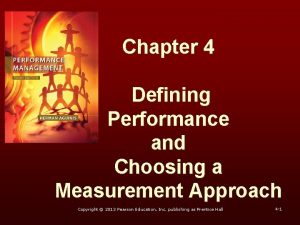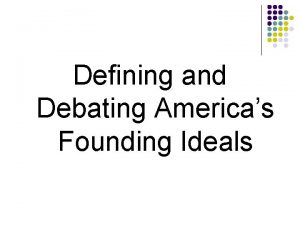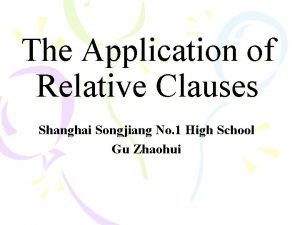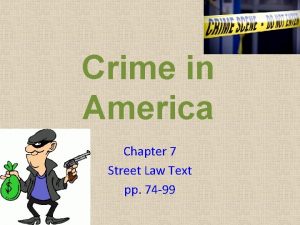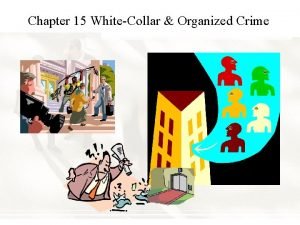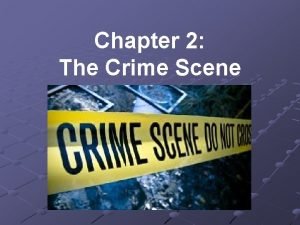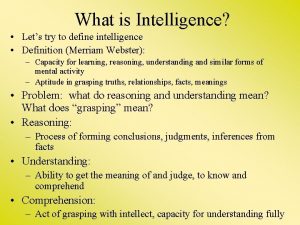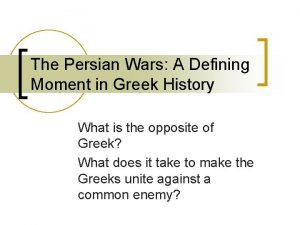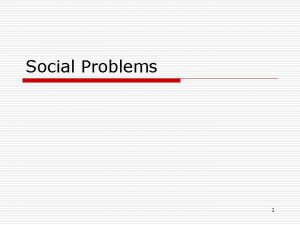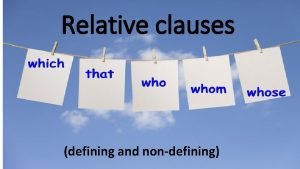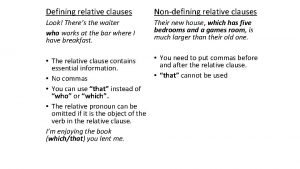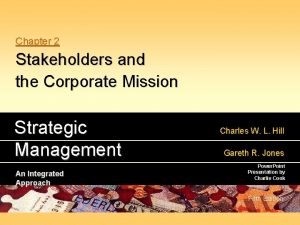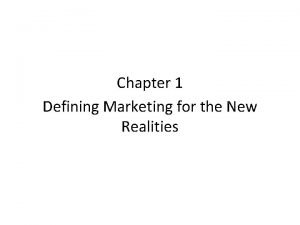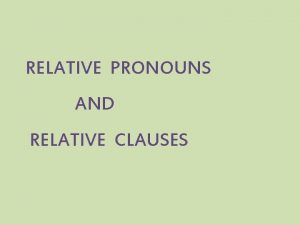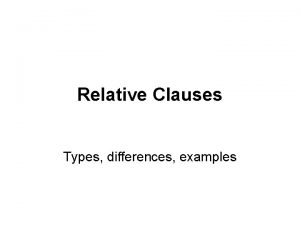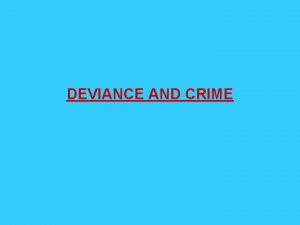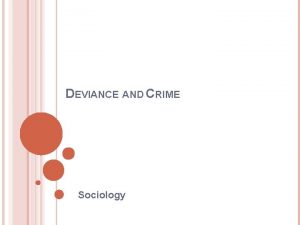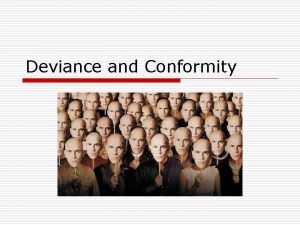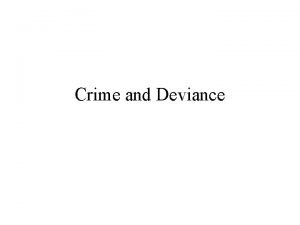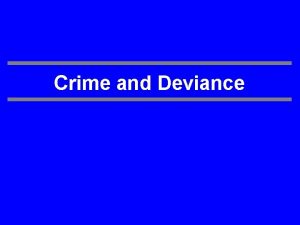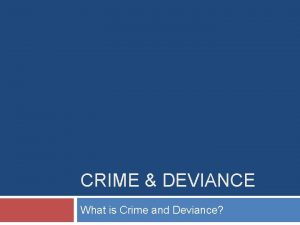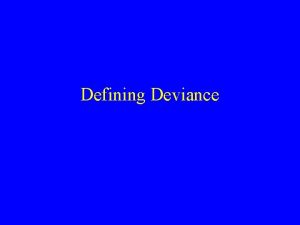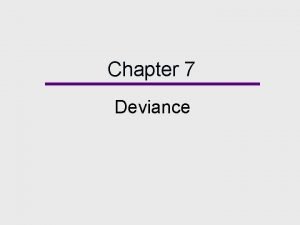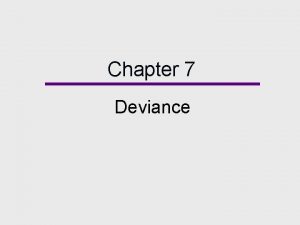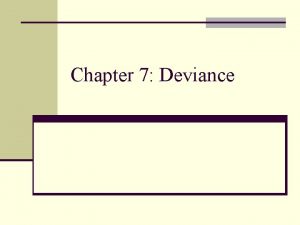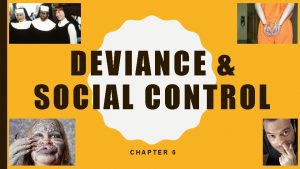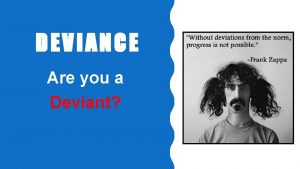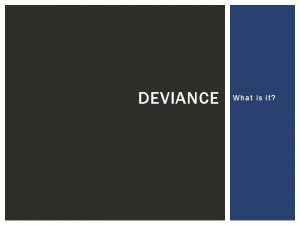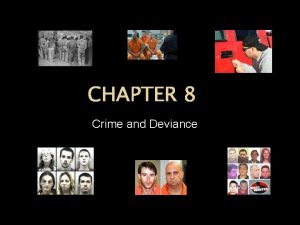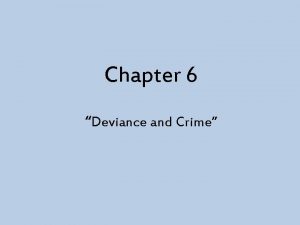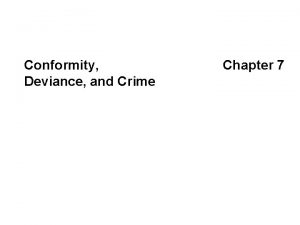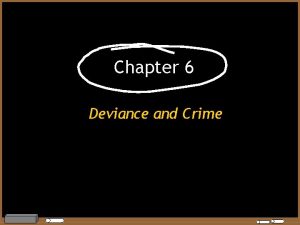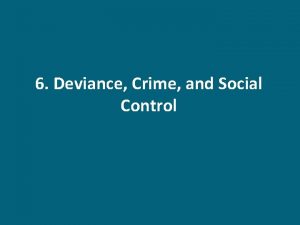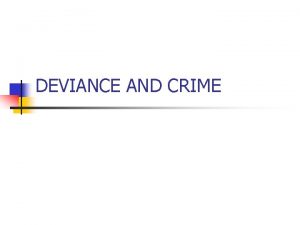Chapter 6 Deviance and Crime Chapter Outline Defining














































































- Slides: 78

Chapter 6 Deviance and Crime

Chapter Outline • • • Defining Deviance Sociological Theories of Deviance Forms of Deviance Crime and Criminal Justice Terrorism as International Crime: A Global Perspective

Defining Deviance • • Behavior that is recognized as violating expected rules and norms. Behavior that departs significantly from social expectations.

Sociological Definition of Deviance • • • Stresses social context, not individual behavior. Recognizes that not all behaviors are judged similarly by all groups. Recognizes that established rules and norms are socially created.

Sociological Perspectives of Deviance Functionalism Deviance creates social cohesion. Symbolic Interaction Deviance is learned behavior. Conflict Theory Dominant classes control the definition of deviance.

Sociological Perspectives of Deviance Functionalism Deviance results from structural strains in society. Symbolic Interaction Deviance results from social labeling. Conflict Theory Deviance results from inequality in society.

Sociological Perspectives of Deviance Functionalism Occurs when attachment to social bonds is diminished Symbolic Interaction Those with the power to assign deviant labels create deviance. Conflict Theory Elite deviance goes largely unpunished.

Debunking Society’s Myths • • Myth: • Deviance is bad for society because it disrupts normal life. Sociological perspective: • Deviance tends to stabilize society. By defining some behavior as deviant, people affirm the social norms of groups. In this sense, society creates deviance to some extent.

Defining Deviance • • This distributed photo of a woman being executed by the Taliban illustrates the extreme sanctions that can be brought against those defined as deviant by a powerful group. This photo mobilized world condemnation of the Taliban regime for its treatment of women.

Smoking and Deviance • Once considered “cool”, smokers are now considered to be deviants, scorned as polluters, and often banished to outside office buildings, as here.

Durkheim: Three Types of Suicide 1. 2. 3. Anomic - disintegrating forces in society make an individual feel lost and alone. Altruistic - for the sake of a higher cause. Egoistic - occurs when people feel totally detached from society.

Question • _______ suicide occurs when the disintegrating forces in the society make individuals feel lost or alone.

Answer: anomic • Anomic suicide occurs when the disintegrating forces in the society make individuals feel lost or alone.

The Navajo • Strong ties among the Navajo produce social integration, resulting in the fact that the Navajo have one of the lowest suicide rates of any group in the United States, and also lowest among other Native American tribal groups.


Merton’s Structural Strain Theory • • • Culture establishes goals for people. Social structures provide, or fail to provide, the means for people to achieve those goals. Imbalance between cultural goals and structurally available means can compel individuals into deviant behavior.

Merton’s Structural Strain Theory Conformity Innovative deviance Ritualistic deviance Cultural goals accepted? Institutionalized means toward goal available? Yes Yes No No Yes

Merton’s Structural Strain Theory Cultural goals accepted? Institutionalized means toward goal available? Retreatism deviance No No Rebellion No (old goals) Yes (new goals) No (old means) Yes (new means)

Social Control Agents • From the point of view of conflict theory, social control agents play a significant role in defining deviant behavior.

Social Control Theory: Hirschi • • Travis Hirschi developed social control theory to explain the occurrence of deviance. According to social control theory, deviance occurs when a person’s (or group’s) attachment to social bonds is weakened. Most of the time people internalize social norms because of their attachments to others. When that bond is broken, deviance occurs.

Symbolic Interaction Theories Differential Association • Deviant behavior is learned through interaction with others. • People pass on deviant expectations through their social groups and networks.

Symbolic Interaction Theories Labeling Theory • Responses of others is most significant in deviance. • A person may become deviant because of a label, even if he/she did not engage in deviant behavior.

Deviant Communities • • Some deviance develops in deviant communities, such as the “skinheads” shown here marching in a Ku Klux Klan rally protesting the Martin Luther King, Jr. holiday. Such right-wing extremist groups have become more common in recent years.

Theories of Deviance: Mental Illness Functionalists By recognizing mental illness, society upholds values about conforming behavior. Symbolic Interactionist Mentally ill are victims of societal reactions to their behavior. Labeling and Conflict theory People with few resources are most likely to be labeled mentally ill.

Debunking Society’s Myths • • Myth: • Mental illness is an abnormality best studied by psychologists and physicians. Sociological perspective: • Mental illness is subject to a significant labeling effect. Those who study and treat mental illness benefit from combining a sociological perspective with medical and psychological knowledge.

Social Stigmas • • • A stigma is an attribute that is socially devalued and discredited. People with stigmas are defined in terms of their presumed deviance. In hiding their stigma, they isolate themselves from communities where they can find support.

Substance Abuse • Patterns of use vary by many factors such as age, gender, and race: • People under age 25 are more likely to use marijuana and cocaine and binge drink. • Men are more likely than women to be problem drinkers and drug abusers. • African Americans and Hispanics are less likely to drink than Whites and are far less likely to be binge drinkers.

Question • A ____ is an attribute that is socially devalued and discredited.

Answer: stigma • A stigma is an attribute that is socially devalued and discredited.

Conformity • This man’s extreme spiked hairdo shows deviant behavior in society but rigid conformity to the norms of the peer group or deviance community

Use of Selected Substances by High School Seniors

Question • Did you ever use marijuana during your senior year in high school? a) Yes b) No

Question • I believe that underage drinking is an important social problem in our society. a) Strongly agree b) Agree somewhat c) Unsure d) Disagree somewhat e) Strongly disagree

Crime and Deviance • • • Crime is a type of deviant behavior, but not all deviant behavior would be called crime. Deviance becomes crime when it is designated by the institutions of society as violating such a law or laws. Criminology is the study of crime from a scientific perspective.

Sociological Theories of Crime Functionalist Crime is learned through social interaction. Symbolic Interaction Societies need a certain level of crime to clarify norms. The lower the social class, the Conflict Theory more the individual is forced into criminality.

Sociological Theories of Crime Functionalist Crime results from social structural strains within society. Symbolic Interaction Labeling criminals tends to reinforce rather than deter crime. Inequalities in society tends to Conflict Theory produce criminal activity.

Sociological Theories of Crime Functionalist Crime may be functional to society, thus difficult to eradicate. Symbolic Interaction Institutions with the power to label produce rather than lessen crime. Conflict Theory Reducing social inequalities will reduce crime.

Violent Crime in the United States

Classifications of Crimes • • Personal crimes - murder, aggravated assault, rape, robbery Property crimes - burglary, larceny, auto theft, arson

Classifications of Crimes • • Victimless crimes - gambling, illegal drug use, prostitution Hate crimes - assaults and other malicious acts motivated by bias

Question • Have you ever stolen little things worth between $2 and $50? a) Yes b) No

Question • Have you ever stolen things worth more than $50? a) Yes b) No

Debunking Society’s Myths • • Myth: • The only real crimes are offenses such as robbery, assault, murder, and the like. Sociological perspective: • Examples of what people do not usually consider to be crimes are “elite” crimes such as income tax evasion, insider trading, embezzlement, and faulty business accounting practices.

Organized Crime • This dinner gathering of HBO’s “Sopranos” gang illustrates both the hierarchy and group cohesion that characterizes organized crime.

White-collar or Elite Crime • • Examples: embezzlement, insider trading, tax evasion In terms of dollars, white-collar crime is much more consequential for society than street crimes.

White collar Crime • • Andrew S. “Fast Andy” Fastow, former chief financial officer of the Enron corporation, is being taken to court by FBI agents. Martha Stewart the media/household tycoon, spent five months in prison for stock fraud.

Organized Crime • • Crime committed by organized groups, typically involving the provision of illegal goods and services to others. Organized crime syndicates include any group that exercises control over large illegal enterprises, such as the drug trade, illegal gambling, prostitution or weapons smuggling.

Corporate Crime and Deviance • • • Occurs in the context of a formal organization or bureaucracy and is sanctioned by the norms and operating principles of the organization. Can occur within any of organization: corporate, educational, governmental, or religious. Example: Sexual assault of youths by Catholic priests, and the attempted cover-ups by assigning offending priests to parishes in different towns or states.

Race, Class, Gender and Crime • • • Certain groups are more likely than others to commit crime given that crime is linked to patterns of inequality in society. Sociologist Ramiro Martinez Jr. explored the connection between rates of violence in Latino communities and the degree of inequality in 111 U. S. cities. His research shows a clear link between likelihood of lethal violence and socioeconomic conditions for Latinos in these different cities.

Race and Crime • • Minorities constitute 25% of the population of the United States but are more than 33% of the people arrested for property crimes and almost 50% of the people arrested for violent crimes. Sociological research has shown that police discretion is strongly influenced by class and race judgments.

Victimization by Crime: A Class Phenomenon

Debunking Society’s Myths • • Myth: • The criminal justice system treats all people according to the neutral principles of law. Sociological perspective: • Even when convicted of the same crime as Whites, African American and Latino male defendants with the same prior arrest record are more likely to be arrested and sentenced, and to be sentenced for longer terms than White defendants.

Arrests by Race Asian/ Pacific Islander Crime White Black American Indian Murder 48. 7 48. 8 1. 0 1. 5 Forcible Rape 63. 7 34. 1 1. 1 Robbery 44. 2 53. 9 0. 6 1. 2 Forgery 68. 0 30. 0 0. 6 1. 4

Incarceration Rates for Selected Nations

State and Federal Prison Population, 1980– 2004

Question • Which of the following is not considered an example of a victimless crime? a) arson b) illegal drug use c) gambling d) prostitution

Answer: a • Arson is not considered an example of a victimless crime.

Terrorism • • A crime that violates international and domestic laws. Terrorism, whether domestic or international, is best understood not only as individual insanity, but also as a politically, economically, and socially oriented form of violence.

Terrorism • Threats of terrorism, such as bioterrorism, have resulted in increased security and countermeasures, particularly in urban areas.

Quick Quiz

1. The sociological definition of deviance stresses: a) the individual who is deviant b) the behavior defined as deviant c) the social context in which deviance occurs d) the personality types related to deviance

Answer: c • The sociological definition of deviance stresses the social context in which deviance occurs.

2. Emile Durkheim argued that: a) deviance is learned through social interaction b) deviance is functional to society because it produces solidarity c) those with the most power in society define who is deviant d) individual factors cause deviant behavior

Answer: b • Emile Durkheim argued that deviance is functional to society because it produces solidarity.

3. Functionalist theorists argue that deviance: a) results from inequality in society b) is a learned behavior c) is reinforced through group membership d) creates social cohesion

Answer: d • Functionalist theorists argue that deviance creates social cohesion.

4. Which of the following statements about social control theory is true? a) society often fails to provide legitimate means to accomplish cultural goals b) people become criminals when they are more strongly socialized to break the law c) the economic organization of capitalist societies produces deviance d) most of the time people internalize social norms because of their attachments to others

Answer: d • The statement that most of the time people internalize social norms because of their attachments to others is true.

5. Labeling theory interprets the responses of others as the most significant factor in understanding how deviant behavior is both created and sustained a) True b) False

Answer: True • Labeling theory interprets the responses of others as the most significant factor in understanding how deviant behavior is both created and sustained.

6. The study of crime from a scientific perspective is called: a) Criminal justice b) Criminology c) Criminal behaviorism d) Criminal studies

Answer: b • The study of crime from a scientific perspective is called criminology.

7. "The lower the social class, the more the individual is forced into criminality. " This statement most closely reflects the: a) evolutionary perspective b) conflict perspective c) functionalist perspective d) symbolic interactionist perspective

Answer: b • "The lower the social class, the more the individual is forced into criminality. " This statement most closely reflects the conflict perspective.

8. Which of the following is not considered an example of property crimes? a) arson b) larceny c) burglary d) gambling

Answer: d • Gambling is not considered an example of property crimes.

9. _________ refers to criminal activities by persons of high social status who commit their crimes in the context of their occupation. a. Property crimes b. Personal crimes c. Elite crime d. Hate crimes

Answer: c • Elite crime refers to criminal activities by persons of high social status who commit their crimes in the context.
 Chapter 7 deviance crime and social control
Chapter 7 deviance crime and social control Pseudo r-square
Pseudo r-square Non defining relative clauses
Non defining relative clauses Relative clauses defining and non defining
Relative clauses defining and non defining Non defining relative clauses as sentence modifiers
Non defining relative clauses as sentence modifiers Defining and non defining relative clauses in telugu
Defining and non defining relative clauses in telugu Defining non defining relative clauses
Defining non defining relative clauses Relative clauses örnekleri
Relative clauses örnekleri Crime and deviance sociology revision
Crime and deviance sociology revision Difference between crime and deviance
Difference between crime and deviance Crime and deviance definition
Crime and deviance definition Marxism crime and deviance
Marxism crime and deviance Primary deviance definition
Primary deviance definition Chapter 6 deviance and social control
Chapter 6 deviance and social control Sandwich statements
Sandwich statements Primary and secondary deviance
Primary and secondary deviance Inner and outer controls work against deviance
Inner and outer controls work against deviance Lesson quiz 7-1 deviance and social control
Lesson quiz 7-1 deviance and social control Primary and secondary deviance
Primary and secondary deviance Primary and secondary deviance
Primary and secondary deviance Behavior that violates significant social norms is called
Behavior that violates significant social norms is called Social control and deviance guided reading section 1
Social control and deviance guided reading section 1 Ethics and deviance in sport a level pe
Ethics and deviance in sport a level pe Primary and secondary deviance examples
Primary and secondary deviance examples Deviant acts examples
Deviant acts examples Strain theory examples
Strain theory examples Chapter 2 crime scene investigation and evidence collection
Chapter 2 crime scene investigation and evidence collection Deviant examples
Deviant examples What is political deviance
What is political deviance Definition of deviance amplification
Definition of deviance amplification Normalization of deviance ppt
Normalization of deviance ppt Functionalist perspective on deviance
Functionalist perspective on deviance Deviance regulation theory
Deviance regulation theory Deviant overconformity
Deviant overconformity Deviant definition examples
Deviant definition examples Criminal deviance
Criminal deviance Acts of deviance
Acts of deviance Corporate deviance definition
Corporate deviance definition Example of deviance sociology
Example of deviance sociology Cultural deviance theory sociology
Cultural deviance theory sociology Examples of deviance in society
Examples of deviance in society Labeling theory
Labeling theory Biological explanation of deviance
Biological explanation of deviance Relative deviance
Relative deviance Positive deviance sociology definition
Positive deviance sociology definition Underconformity
Underconformity The most common form of production deviance is
The most common form of production deviance is Pepinsky social control
Pepinsky social control Lemert primary deviance
Lemert primary deviance Lesson 15-1 defining and evaluating a logarithmic function
Lesson 15-1 defining and evaluating a logarithmic function Define the problem and research objectives
Define the problem and research objectives What are the approaches to measuring performance
What are the approaches to measuring performance Exploratory research question examples
Exploratory research question examples Nested member function
Nested member function Defining performance and choosing a measurement approach
Defining performance and choosing a measurement approach Defining and debating america's founding ideals
Defining and debating america's founding ideals Defending and non defining relative clauses
Defending and non defining relative clauses Chapter 7 crime in america pdf
Chapter 7 crime in america pdf Born a crime chapter 15
Born a crime chapter 15 Chapter 2 the crime scene
Chapter 2 the crime scene Intelligence vs intelligent
Intelligence vs intelligent The defining moment in greek history is the wars
The defining moment in greek history is the wars Four traits of chordates
Four traits of chordates Sociological perspectives on social problems
Sociological perspectives on social problems Lord capulet defining quotes
Lord capulet defining quotes Lady montague defining quotes
Lady montague defining quotes Non-defining relative clauses as sentence modifiers
Non-defining relative clauses as sentence modifiers Poverty definitions
Poverty definitions Program block and control section
Program block and control section Leadership ki paribhasha
Leadership ki paribhasha Rephrasing research problem
Rephrasing research problem Non defining relatives clauses
Non defining relatives clauses Defining marketing for the 21st century
Defining marketing for the 21st century Abell's framework for defining the business
Abell's framework for defining the business Defining marketing for the new realities ppt
Defining marketing for the new realities ppt All stoichiometric calculations begin with a
All stoichiometric calculations begin with a Defining stoichiometry worksheet answers
Defining stoichiometry worksheet answers Combine these sentences using non-defining relative clauses
Combine these sentences using non-defining relative clauses Connective relative clause examples
Connective relative clause examples

